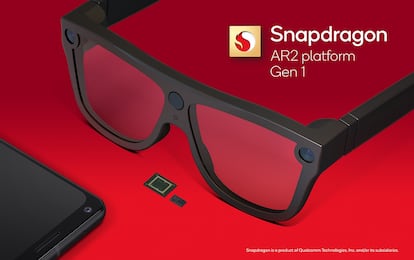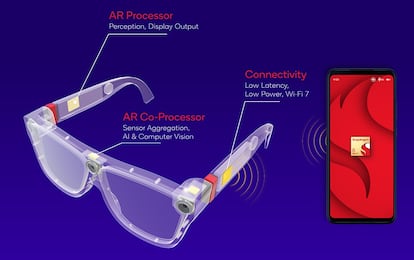Glasses with smartphone capabilities and real-time Photoshop: Introducing the Snapdragon chipset
The new chip paves the way for a host of new features, as well as improved performance and lower energy consumption


Chips are to computing what neurons are to our body: basic functional units whose main task is to receive, process and transmit information. Their development determines if applications can become more sophisticated, handle artificial intelligence, process increasing amounts of data and reproduce clearer, more realistic images and sounds. Each advance in these integrated circuits drives the rest of the industry to develop new capabilities for smartphones, cars, household appliances, computers and more.
This month Qualcomm unveiled its newest chipset, the Snapdragon 8 Gen 2, designed to use artificial intelligence, increase performance fourfold and reduce energy consumption by up to 60%. These are the three basic fields that are also being developed by other companies such as Intel, Samsung, Taiwan Semiconductor Manufacturing (TSMC) and Apple – which in June began to develop its own family of chips for the Mac, the M2. Here are some of the developments brought by Qualcomm’s latest advances:
The processor. Cristiano Amon, president of Qualcomm, believes that the next five years will be oriented towards technological convergence: providing other devices with smartphone capabilities while giving phones some of the benefits of computers and consoles. The Snapdragon 8 Gen 2 platform was developed with this in mind and, starting next year, companies such as Samsung, Honor, OnePlus, Sony, Xiaomi and Motorola will make it part of their high-end devices. Its specs are: a 4-nanometer processor (more efficient and capable); a main core with a maximum frequency of 3.2 GHz, three of 2.8 and four of 2, and support for 5G networks. Also, downloads of 10 Gigabits per second and peak performance with Wi-Fi 7, the latest wireless technology. Chris Patrick, vice president of the company, says that it offers innovative artificial intelligence, unparalleled connectivity and professional quality games.
Glasses, which aspire to dethrone the watch. Amon is convinced that glasses will become the next big wearable. They are conventional-looking glasses that will place all mobile applications a few millimeters from your eyes. Things like street directions, a video call, your latest messages, information related to what you see, a movie or the metaverse will be displayed on the lenses. Amon believes that they will start to become available in the next “five to 10 years.” From a technological point of view, he points out, it is absolutely feasible; it is only a matter of time.

The foundation for this near future is the Snapdragon AR2 Gen 1, a multi-chip architecture that includes an augmented reality processor on one temple, an augmented reality coprocessor in the middle of the frame and a connectivity system that uses FastConnect 7800 on the other temple. With this distribution of elements, up to nine cameras can be used, the performance of artificial intelligence can increase 2.5 times, power consumption can decrease by 50% and, most importantly, the entire device can fit in a conventional frame.
Language. The artificial intelligence engine has paved the way for Snapdragon Smart, a natural language processing system that facilitates simultaneous translation into several languages, and Sensing Hub, which allows users to give increasingly complex commands to voice assistants, so “find a restaurant” or “find a hotel near me” can become “locate a place with Chinese food for less than $20 that’s less than 10 minutes away” or “a four-star hotel with a gym, babysitting service and that’s close to the beach, for less than $200 a night.”
Instant Photoshop. Adobe is working with Qualcomm in the development of Snapdragon Sight, a platform that aims to bring the professional photography experience to smartphone cameras using real-time semantic segmentation for photos and videos. Just like Photoshop, this feature identifies the different layers of an image, such as faces, features, hair, clothing, sky or background, to optimize them with artificial intelligence as the image is being taken. Companies such as Sony or Samsung also apply the Qualcomm platform to their image sensors to achieve shots of up to 200 megapixels and high-definition videos in 8K resolution.

Gaming. Faster execution (25%), more realism and lower consumption (40%) are the keys to Snapdragon Elite Gaming, with which developers can create more realistic and immersive graphics with ray tracing for mobile gaming without draining the battery. The game developer Niantic has already announced that it will incorporate this technology.
Connection. The new processing platform is linked to 5G connectivity and Wi-Fi 7, the latest generation of wireless connection, thanks to the X70 modem, to gain in speed, capacity, coverage, latency and energy efficiency. It also doubles the Bluetooth connection range and allows for the simultaneous use of two SIM cards.

Sound. Another goal of the new developments is to improve the experience of music, calls, video and gaming applications. The idea is to not only improve clarity and immersive capacity, but to use artificial intelligence possible to discriminate and cancel sounds, for example, all external noises during a conversation.
Computers. Technological convergence does not only mean advances for smartphones; the goal is to bring mobile technology to all devices, especially laptops, and machinery, such as cars. In this sense, the collaboration between Qualcomm and Microsoft will allow the incorporation of artificial intelligence acceleration systems to Windows 11, not only to improve image and sound applications (Windows Studio Effects Voice Focus and Background Blur) but, above all, to take advantage of the advances in artificial intelligence to improve the performance and energy efficiency of CPUs (central processing units) and GPUs (graphics processing units).
Tu suscripción se está usando en otro dispositivo
¿Quieres añadir otro usuario a tu suscripción?
Si continúas leyendo en este dispositivo, no se podrá leer en el otro.
FlechaTu suscripción se está usando en otro dispositivo y solo puedes acceder a EL PAÍS desde un dispositivo a la vez.
Si quieres compartir tu cuenta, cambia tu suscripción a la modalidad Premium, así podrás añadir otro usuario. Cada uno accederá con su propia cuenta de email, lo que os permitirá personalizar vuestra experiencia en EL PAÍS.
¿Tienes una suscripción de empresa? Accede aquí para contratar más cuentas.
En el caso de no saber quién está usando tu cuenta, te recomendamos cambiar tu contraseña aquí.
Si decides continuar compartiendo tu cuenta, este mensaje se mostrará en tu dispositivo y en el de la otra persona que está usando tu cuenta de forma indefinida, afectando a tu experiencia de lectura. Puedes consultar aquí los términos y condiciones de la suscripción digital.
More information
Archived In
Últimas noticias
NASA discovers Titan doesn’t have an ocean, but a ‘slushy ice layer’ that increases possibility of life
Innocence lost in the forest of the child soldiers: ‘Each leader of the armed group had his girls’
‘Fallout’ or how the world’s largest company turned an anti-capitalist apocalyptic Western into a phenomenon
From inflation to defending migrants: Eileen Higgins and Zohran Mamdani inaugurate the new Democratic resistance against Trump
Most viewed
- ‘El Limones’ and the growing union disguise of Mexican organized crime
- Christian Louboutin: ‘Young people don’t want to be like their parents. And if their parents wear sneakers, they’re going to look for something else’
- The low-cost creative revolution: How technology is making art accessible to everyone
- ‘We are dying’: Cuba sinks into a health crisis amid medicine shortages and misdiagnosis
- Liset Menéndez de la Prida, neuroscientist: ‘It’s not normal to constantly seek pleasure; it’s important to be bored, to be calm’









































